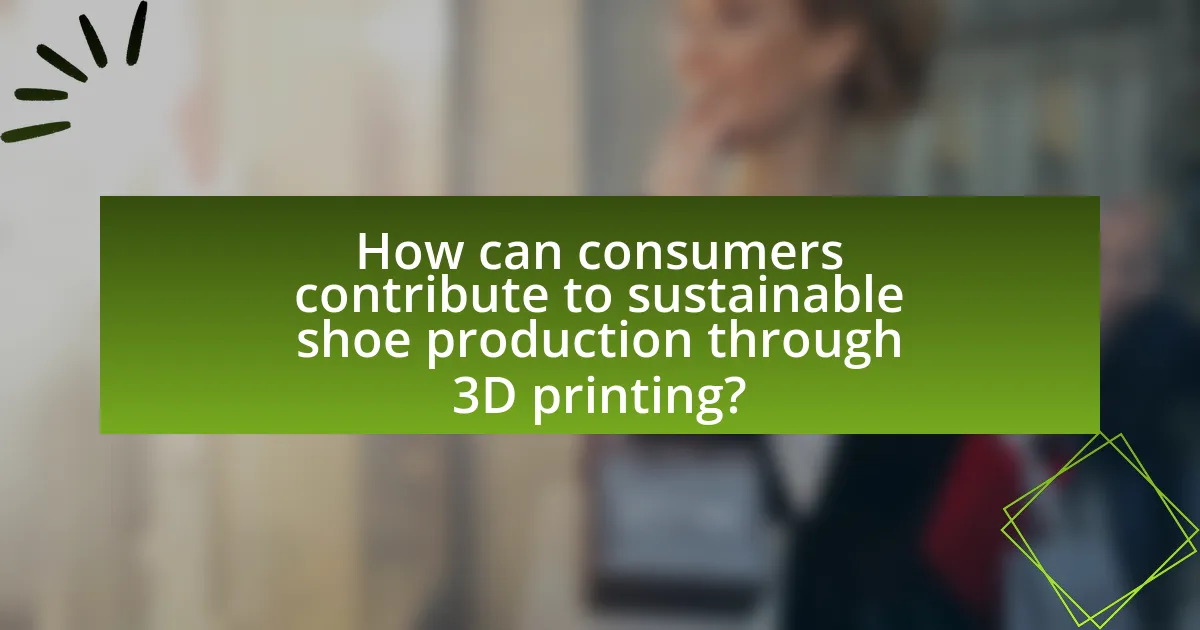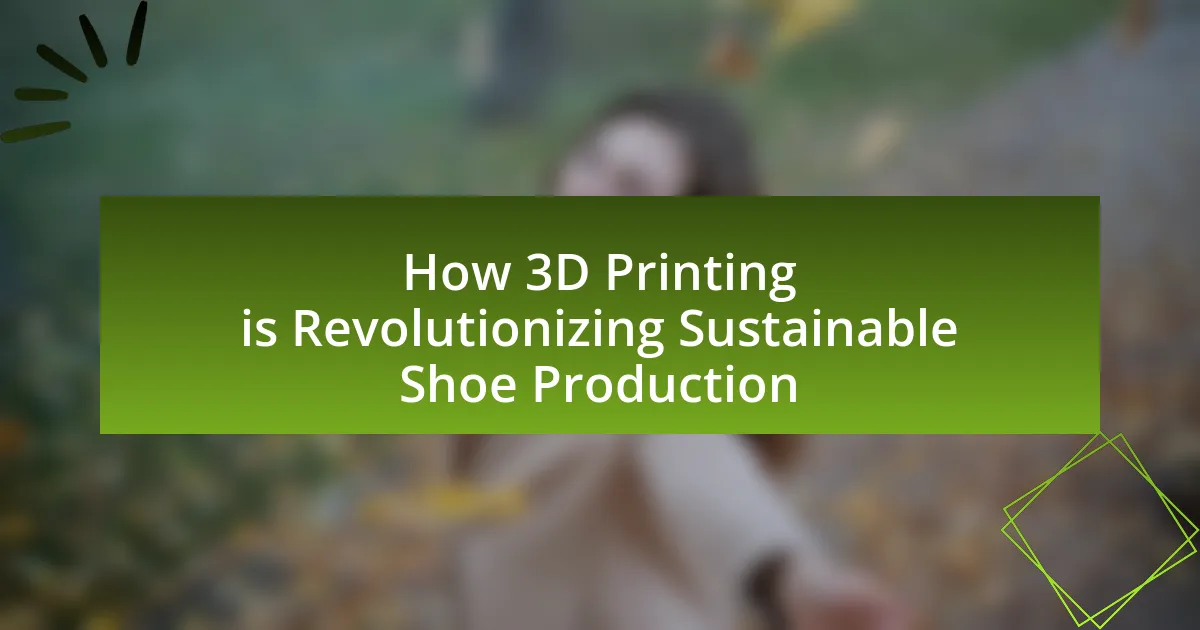The article focuses on how 3D printing is revolutionizing sustainable shoe production. It highlights the technology’s ability to enable customized designs, reduce material waste, and streamline manufacturing processes, thereby enhancing comfort and fit while promoting environmental sustainability. Key advantages of 3D printing in shoe manufacturing include faster production times and the use of eco-friendly materials, which significantly lower carbon footprints. The article also discusses the challenges faced by the footwear industry in adopting this technology and explores future trends, consumer behavior, and the role of brands in promoting sustainable practices through 3D printing.

How is 3D Printing Transforming Shoe Production?
3D printing is transforming shoe production by enabling customized designs, reducing waste, and streamlining manufacturing processes. This technology allows brands to create shoes tailored to individual foot shapes and preferences, enhancing comfort and fit. Additionally, 3D printing minimizes material waste, as it uses only the necessary amount of material for each shoe, contrasting with traditional methods that often result in excess waste. For instance, companies like Adidas have implemented 3D printing in their production lines, leading to a significant reduction in material usage and a more sustainable approach to manufacturing. This shift not only improves efficiency but also aligns with the growing demand for environmentally friendly practices in the fashion industry.
What are the key advantages of using 3D printing in shoe manufacturing?
The key advantages of using 3D printing in shoe manufacturing include customization, reduced waste, and faster production times. Customization allows manufacturers to create shoes tailored to individual foot shapes and preferences, enhancing comfort and fit. Reduced waste is achieved through additive manufacturing, which uses only the necessary materials, minimizing excess and scrap. Faster production times result from the ability to quickly prototype and produce designs, significantly shortening the time from concept to market. These advantages contribute to a more sustainable and efficient shoe production process.
How does 3D printing reduce material waste in shoe production?
3D printing reduces material waste in shoe production by utilizing additive manufacturing techniques that create products layer by layer, which minimizes excess material. Traditional shoe manufacturing often involves cutting materials from larger sheets, leading to significant waste; in contrast, 3D printing only uses the material necessary for the design, resulting in up to 90% less waste. This efficiency not only conserves resources but also allows for more precise customization, further enhancing sustainability in the production process.
What role does customization play in sustainable shoe production through 3D printing?
Customization significantly enhances sustainable shoe production through 3D printing by allowing for precise design adjustments that minimize material waste. This technology enables manufacturers to create shoes tailored to individual specifications, reducing the need for excess inventory and the environmental impact associated with mass production. For instance, a study by the Massachusetts Institute of Technology found that 3D printing can reduce material usage by up to 90% compared to traditional manufacturing methods. This level of customization not only meets consumer demand for unique products but also aligns with sustainability goals by promoting efficient resource use and reducing the carbon footprint associated with shoe production.
Why is sustainability important in the footwear industry?
Sustainability is crucial in the footwear industry because it addresses environmental concerns associated with traditional manufacturing processes. The footwear sector is responsible for significant waste and pollution, with estimates indicating that around 300 million pairs of shoes are discarded annually in the U.S. alone, contributing to landfill overflow and environmental degradation. Sustainable practices, such as using eco-friendly materials and reducing carbon footprints through innovative technologies like 3D printing, can minimize these negative impacts. For instance, 3D printing allows for precise material usage, reducing waste and enabling the production of shoes with a lower environmental impact.
How does traditional shoe production impact the environment?
Traditional shoe production significantly impacts the environment through resource depletion, pollution, and waste generation. The manufacturing process often involves the use of non-renewable resources, such as petroleum-based materials, which contribute to environmental degradation. Additionally, traditional methods typically release harmful chemicals and pollutants into the air and water, with the footwear industry being responsible for approximately 1.4 billion tons of CO2 emissions annually. Furthermore, the production process generates substantial waste, with estimates suggesting that around 300 million pairs of shoes are discarded each year in landfills, exacerbating the global waste crisis.
What are the social implications of sustainable shoe production?
Sustainable shoe production has significant social implications, primarily by promoting ethical labor practices and reducing environmental harm. By prioritizing sustainable materials and production methods, companies can ensure fair wages and safe working conditions for workers, which enhances community well-being. For instance, brands that adopt sustainable practices often engage in transparent supply chains, fostering accountability and trust among consumers. Additionally, sustainable shoe production can lead to increased awareness of environmental issues, encouraging consumers to make more responsible purchasing decisions. This shift not only benefits the planet but also cultivates a culture of sustainability within communities, ultimately contributing to social equity and environmental justice.
What technologies are involved in 3D printing for shoes?
The technologies involved in 3D printing for shoes include Fused Deposition Modeling (FDM), Selective Laser Sintering (SLS), and Digital Light Processing (DLP). FDM utilizes thermoplastic materials to create layers, allowing for customizable designs and rapid prototyping. SLS employs a laser to fuse powdered materials, enabling the production of complex geometries and lightweight structures. DLP uses a digital light projector to cure liquid resin, resulting in high-resolution prints suitable for intricate shoe components. These technologies collectively enhance design flexibility, reduce material waste, and promote sustainable practices in shoe production.
What types of 3D printing methods are commonly used in shoe production?
The types of 3D printing methods commonly used in shoe production include Fused Deposition Modeling (FDM), Selective Laser Sintering (SLS), and Digital Light Processing (DLP). FDM is widely utilized for creating prototypes and custom designs due to its accessibility and cost-effectiveness. SLS is favored for producing durable and complex geometries, as it uses a laser to fuse powdered materials, allowing for lightweight structures. DLP, on the other hand, is employed for high-resolution prints, particularly in creating intricate details and smooth surfaces. These methods collectively enhance the efficiency and sustainability of shoe production by minimizing waste and enabling rapid prototyping.
How do different materials affect the sustainability of 3D printed shoes?
Different materials significantly impact the sustainability of 3D printed shoes by influencing their environmental footprint, durability, and recyclability. For instance, biodegradable materials like PLA (polylactic acid) reduce plastic waste and can decompose in industrial composting facilities, making them more sustainable than traditional plastics. In contrast, materials such as TPU (thermoplastic polyurethane) offer durability and flexibility but may not be as easily recyclable, potentially leading to increased waste. Research indicates that using recycled materials, such as rPET (recycled polyethylene terephthalate), can further enhance sustainability by reducing reliance on virgin resources and minimizing energy consumption during production. Thus, the choice of material directly affects the overall sustainability profile of 3D printed shoes.
How does 3D printing influence consumer behavior in the footwear market?
3D printing significantly influences consumer behavior in the footwear market by enabling customization and reducing production waste. Consumers increasingly prefer personalized products, and 3D printing allows for tailored designs that meet individual preferences, enhancing customer satisfaction. According to a study by the Consumer Technology Association, 70% of consumers express interest in customized footwear options, indicating a shift towards personalized shopping experiences. Additionally, the technology minimizes material waste, appealing to environmentally conscious consumers; a report from the Ellen MacArthur Foundation states that 3D printing can reduce waste by up to 90% compared to traditional manufacturing methods. This alignment with sustainability values further drives consumer interest and purchasing decisions in the footwear sector.
What challenges does the footwear industry face in adopting 3D printing?
The footwear industry faces several challenges in adopting 3D printing, primarily related to material limitations, production speed, and cost-effectiveness. Current 3D printing technologies often struggle to produce durable and flexible materials that can match traditional footwear standards, which limits their application in high-performance shoes. Additionally, the speed of production using 3D printing is generally slower compared to conventional manufacturing methods, making it less viable for mass production. Cost is another significant barrier; while 3D printing can reduce waste and allow for customization, the initial investment in technology and materials can be high, deterring smaller manufacturers from making the transition. These challenges hinder the widespread adoption of 3D printing in the footwear sector, despite its potential for sustainable production.

What are the future trends in 3D printing for sustainable shoe production?
Future trends in 3D printing for sustainable shoe production include the use of bio-based materials, increased customization, and the integration of recycling technologies. Bio-based materials, such as plant-derived polymers, are being developed to reduce reliance on fossil fuels and minimize environmental impact. Customization allows for on-demand production, reducing waste associated with overproduction and unsold inventory. Additionally, advancements in recycling technologies enable the use of post-consumer waste in the 3D printing process, further promoting sustainability. These trends are supported by research indicating that 3D printing can significantly lower carbon footprints in manufacturing processes, making it a viable solution for eco-friendly footwear production.
How is innovation shaping the future of 3D printed footwear?
Innovation is significantly shaping the future of 3D printed footwear by enabling customized designs, reducing waste, and enhancing production efficiency. Advanced technologies such as generative design and bio-materials allow for shoes that are tailored to individual foot shapes and preferences, improving comfort and performance. Additionally, 3D printing minimizes material waste compared to traditional manufacturing methods, as it uses only the necessary amount of material for each shoe. According to a study by the Massachusetts Institute of Technology, 3D printing can reduce production waste by up to 90%, making it a more sustainable option. Furthermore, innovations in materials, such as recyclable and biodegradable filaments, are paving the way for environmentally friendly footwear solutions.
What emerging materials are being explored for 3D printed shoes?
Emerging materials being explored for 3D printed shoes include thermoplastic polyurethane (TPU), bio-based polymers, and recycled materials. TPU is favored for its flexibility and durability, making it suitable for various shoe components. Bio-based polymers, derived from renewable resources, offer a sustainable alternative to traditional plastics, while recycled materials, such as repurposed plastics, contribute to reducing waste in the footwear industry. Research indicates that these materials not only enhance performance but also align with sustainability goals in shoe production.
How might consumer preferences evolve with advancements in 3D printing technology?
Consumer preferences are likely to evolve towards greater customization and sustainability with advancements in 3D printing technology. As 3D printing allows for on-demand production, consumers will increasingly favor personalized products that meet their specific needs and preferences, such as unique shoe designs tailored to individual foot shapes. Additionally, the ability to produce shoes with less waste and more sustainable materials will attract environmentally conscious consumers, as studies indicate that 66% of global consumers are willing to pay more for sustainable brands. This shift towards customization and sustainability reflects a broader trend in consumer behavior favoring products that align with personal values and lifestyle choices.
What role do brands play in promoting sustainable practices through 3D printing?
Brands play a crucial role in promoting sustainable practices through 3D printing by integrating eco-friendly materials and processes into their production methods. For instance, companies like Adidas and Nike have adopted 3D printing to create shoes that minimize waste and utilize recycled materials, significantly reducing their environmental footprint. Research indicates that 3D printing can decrease material waste by up to 90% compared to traditional manufacturing methods, highlighting the effectiveness of this technology in sustainable production. By leading the way in adopting these practices, brands not only enhance their sustainability credentials but also influence consumer behavior towards more environmentally responsible choices.
How can brands effectively communicate their sustainable initiatives to consumers?
Brands can effectively communicate their sustainable initiatives to consumers by utilizing transparent messaging that highlights specific environmental benefits and practices. For instance, brands can share detailed information about their use of 3D printing technology, which reduces material waste and energy consumption in shoe production. Research indicates that consumers are more likely to trust brands that provide clear data on their sustainability efforts, such as statistics showing a reduction in carbon footprint or the percentage of recycled materials used. By leveraging social media, engaging storytelling, and certifications from recognized sustainability organizations, brands can enhance consumer awareness and trust in their sustainable initiatives.
What partnerships are essential for advancing sustainable shoe production?
Collaborations between footwear manufacturers, material suppliers, and technology firms are essential for advancing sustainable shoe production. These partnerships enable the integration of innovative materials, such as biodegradable polymers and recycled textiles, into the production process. For instance, companies like Adidas have partnered with Parley for the Oceans to create shoes from ocean plastic, demonstrating how collaboration can lead to sustainable material sourcing. Additionally, partnerships with 3D printing technology providers allow for more efficient production methods that reduce waste and energy consumption, further enhancing sustainability in the footwear industry.

How can consumers contribute to sustainable shoe production through 3D printing?
Consumers can contribute to sustainable shoe production through 3D printing by opting for custom-designed shoes that minimize waste and utilize eco-friendly materials. By choosing to purchase shoes that are 3D printed on demand, consumers help reduce overproduction and excess inventory, which are significant contributors to environmental degradation in the fashion industry. Additionally, many 3D printing processes allow for the use of biodegradable or recycled materials, further enhancing sustainability. Research indicates that 3D printing can reduce material waste by up to 90% compared to traditional manufacturing methods, making it a viable option for environmentally conscious consumers.
What are the best practices for consumers interested in sustainable footwear?
Consumers interested in sustainable footwear should prioritize brands that utilize eco-friendly materials and ethical manufacturing processes. Research indicates that materials such as recycled plastics, organic cotton, and natural rubber significantly reduce environmental impact compared to conventional materials. Additionally, consumers should look for certifications like Fair Trade or Global Organic Textile Standard (GOTS), which ensure ethical labor practices and sustainable sourcing. Engaging in practices such as buying less, choosing quality over quantity, and supporting local artisans can further enhance sustainability efforts. According to a 2021 report by the Ellen MacArthur Foundation, the fashion industry contributes to 10% of global carbon emissions, highlighting the importance of conscious consumer choices in reducing environmental harm.
How can consumers support brands that utilize 3D printing for sustainability?
Consumers can support brands that utilize 3D printing for sustainability by choosing to purchase products made through this technology. By selecting shoes produced with 3D printing, consumers contribute to reduced waste and lower carbon footprints, as this method often uses less material and energy compared to traditional manufacturing processes. For instance, brands like Adidas and Nike have adopted 3D printing to create shoes that minimize excess material, showcasing a commitment to sustainability. Additionally, consumers can advocate for these brands by sharing their positive experiences on social media, thereby increasing awareness and demand for sustainable practices in the footwear industry.
What should consumers look for when choosing 3D printed shoes?
Consumers should look for comfort, fit, material quality, and sustainability when choosing 3D printed shoes. Comfort is essential as 3D printing allows for customized designs that can better conform to individual foot shapes, enhancing wearability. The fit is crucial; consumers should ensure that the shoes are designed to accommodate their specific foot dimensions, which can be achieved through personalized measurements. Material quality is important because high-performance thermoplastics or bio-based materials can enhance durability and reduce environmental impact. Lastly, sustainability should be a key consideration, as many 3D printed shoes are made from recycled or eco-friendly materials, aligning with the growing demand for environmentally responsible products in the footwear industry.



